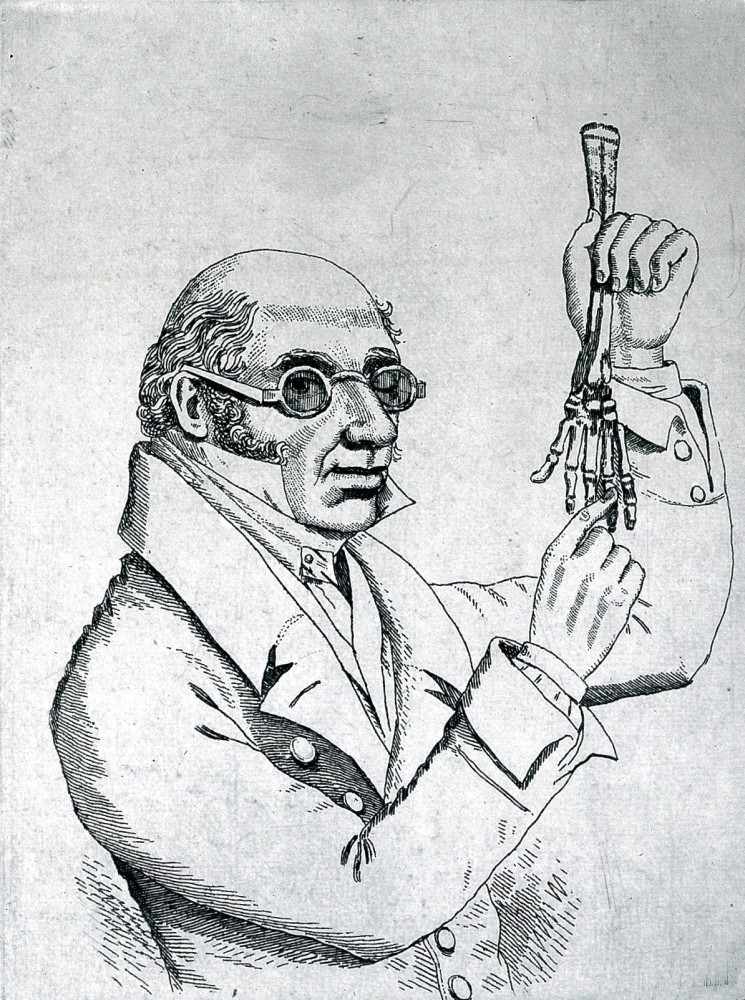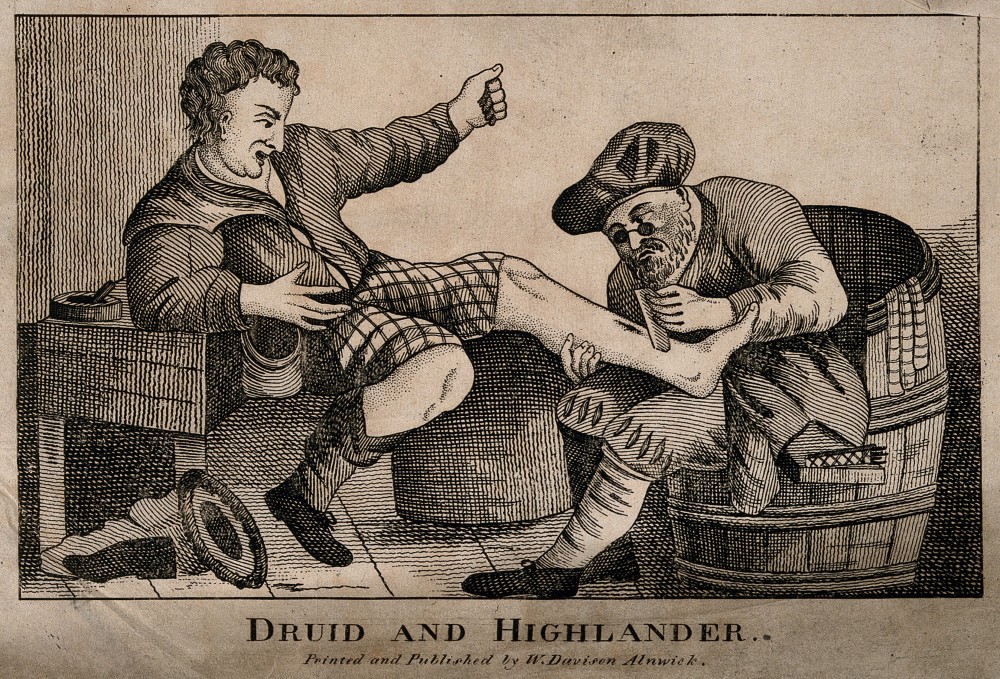
In the second of a two-part blog post, Senior Research Fellow James Kennaway explores the cult of the Scottish solider in relation to racial theories and ethnic identities.
The character of the Celts (i.e. the Irish and the Scots, or perhaps at least the Highlanders, and sometimes also the French – the term was something of a moving target) was a recurring topic in nineteenth-century debates on race and fortitude.[i] Indeed, in the British context, there was more written on this subject than about black troops, which might seem surprising. But the role of Edinburgh in the history of both anaesthesia and racial theory and the over-representation of Irish and Scottish soldiers in the British army at times meant that it was a prominent topic.
While there were plenty of allusions to the common ancestry of the Celts from the Middle Ages, often in terms of supposed shared descent from Brutus of Troy or King Arthur, the word Celt only came to be used as an umbrella term for the non-English peoples of the British Isles in the early eighteenth century. However, as many scholars have subsequently argued, the term ascribes an illusory unity to peoples spread over centuries and thousands of miles who had no idea of the commonalities of language perceived by scholars.[ii] Those theories remained highly speculative and contradictory, and, in the absence (and, indeed, impossibility) of clear demarcations, all of the categories involved were unstable.
A key figure in nineteenth-century debates on racial theory was the Edinburgh anatomist Robert Knox, whose career included the Burke and Hare grave-robbing and murder scandal. He studied medicine in Edinburgh and Paris, working as a surgeon at the Battle of Waterloo and in South Africa, and used those occasions to study the supposed racial characteristics of those under his care.[iii] While he was an abolitionist when it came to slavery, he was also perhaps the leading British racial theorist of his generation, with a particular interest in the ethnic hierarchy within the United Kingdom, with the ‘Saxon’ English and Lowland Scots at the top and the Celtic Irish and Highland Scots as an inferior and dangerous alien breed. As far as the martial qualities are concerned, Knox argued that while ‘the Saxon’ has natural ‘strength and obstinacy’, he despises the servile status of a soldier, but the ‘Celt makes the best of soldiers’ because he is ‘destitute of all self-esteem’.[iv]
The pugnacious irritability of the Irishman, the Welshman and the Highlander, has always been proverbial. In France every man is military. When well disciplined and commanded, the Celt is the best of soldiers; but if not strongly controlled, he is apt to carry liberty to licentiousness. The conduct of the French soldiery in all countries, and the character of a celebrated Irish regiment, are known to all readers of military details’.[v]

Were Scots Celts at all, though? Or only Highlanders? Modern Scottish nationalism, and the historiographical topos of the ‘Celtic Fringe’ has sometimes led to an exaggerated sense of the similarity of Scotland, Ireland and Wales. An explicitly Lowland, Unionist, Presbyterian and often anti-Irish Scottish identity was mainstream for much of the century, fostering a form of Scottish patriotism that contrasts with that which has developed in recent decades. As Colin Kidd and others have noted, many nineteenth-century Lowland Scots were positively aggressive in asserting their Germanic and even ‘English’ character and in distinguishing themselves from the impoverished and marginalised Gaelic-speaking population.[vi] The influence of scientific racism tended to lead to a focus on the Lowland/Highland distinction rather than the Anglo-Scottish border as the real division.
In line with widespread Scottish ‘Saxonism’ of this period, the surgeon William Fergusson suggested that, ‘the Lowland Scot, is of the same Saxon breed as his southern neighbour’. He conceded that he was ‘inferior’ to the Englishman in physique and appearance, but asserted that a rougher life (i.e. environmental causes) made him hardier - ‘uniformly patient, obedient, and brave, never murmuring under any suffering’.[vii] However, he saw a sharp distinction between Lowland and Highland Scots characterised by inherited characteristics. ‘The Highlander (the Celt) comes from a different stock, and it is difficult to conceive two races of men, separated often by the narrowest, or even imaginary boundaries, more distinct than the mountaineer and his lowland neighbour’. The Highlander, he wrote, has a 'peculiar aptitude for war’, being capable of ‘the most exalted heroism’, inspired by the ‘horrible’ sound of bagpipes, but being otherwise as ‘slothful and indolent as the North American Indian’.[viii] Others defended Highlanders by associating them with Germanic qualities. For instance, Richard Cannon’s Historical Record of the Forty-Second (1845), quoting a Dr Jackson on the ‘physical character of the Highland soldier’, wrote that while some were ‘tall and erect, of great muscular power, of a dignified and majestic air, the élite, as it were, of the Gothic race’, most were of ‘low stature, compact and firmly knit in their joints, hardy in bodily frame, without grace or elegance in manner and movement’, but their chief characteristic was being ‘of great endurance… he has an elasticity or pride of mind which does not feel, or which refuses to complain of hardship’ – just the kind of man to endure surgery without murmur.[ix]
A significant flaw in all the assumptions about the natural martial character of Highland troops and their composure under fire or the surgeon’s knife was the sharp decline in the numbers of actual Highlanders in the army. The period in which recruitment in the Highlands peaked was comparatively short, from the 1750s to the 1820s. During their first few decades, such regiments were regularly understood in England as foreign mercenaries. It was the Napoleonic Wars that set the seal on the Britishness of Highland troops, not some point of continuity with the clan past, but rather the result of a proto-capitalist system of patronage. Thereafter, improved prospects in industrial cities at home and increased access to land in the British Empire and United States meant that fewer of the young men of the Highlands chose a military career. The 1881 Army reforms, which made the visual aspect of Lowland regiment align with those in the Highlands, bringing in the kilt, bagpipe and tartan, obscured but did not end the decline in recruitment in the Highlands.[x] The prestige of the Highland regiments was such, however, that they were maintained, simply recruiting more men from outside the Highlands, from the slums of the Scottish Central Belt and beyond.

The advent of thoroughgoing racial theory played a significant role in the trajectory of the reputation of the Highland soldier from the supposed undisciplined ‘bare-arsed banditti’ of the 1745 Jacobite Rebellion to the tartan-clad Unionist emblem of the British Army of the nineteenth century.[xi] Assuming that their apparent toughness in battle and in surgery was a matter of inherited racial characteristics reinforced the idea that Highlanders were natural soldiers for the Empire – something aided by the smoke and mirrors of tartanry used to suggest a Highland character to a group of men increasingly drawn from other areas. Nevertheless, all this is very flattering and many twenty-first-century observers are clearly tempted to go along with the idea of the Scottish or Highland superman without putting it under too much scrutiny.
However, beyond the fact that such racial thinking is both scientifically discredited and politically bankrupt, it is also the case that the ‘natural’ martial valour often ascribed to Highland troops was only one side of a race theory that also blamed the poverty and misery of the Highlands on those same racial characteristics. An 1859 article in The Morning Post was fairly typical in arguing that ‘the influence of race’ explained the fact that Highlanders were ‘gallant in war’ but that their lack of prosperity was due to their character as ‘a toil-hating race’.[xii] This at a time of considerable distress and drastic depopulation in the Highlands. As Alexander Mackenzie pointed out in his 1883 polemic History of the Highland Clearances, many of the ‘brave fellows’ who came back ‘wounded and war-scarred’, whether in combat or surgery, found ‘that their hearths and homes were desecrated and destroyed’.[xiii] A high position in racial hierarchies of heroic fortitude was by no means an unmixed blessing.
This is the second of a two-part blog post. To read part one, click here.
[i] Murray Pittock, Celtic Identity and the British Image (Manchester: Manchester Unversity Press, 1999).
[ii] Quoted in Pittock, p. 6
[iii] Henry Lonsdale, A Sketch of the Life and Writings of Robert Knox, the Anatomist (London: Macmillan and Co., 1870), pp. 288-9.
[iv] Robert Knox, The Races of Men (London: Henry Renshaw, 1863), p. 472.
[v] George Ellis, Irish Ethnology (Dublin: Hodges and Smith, 1852), p. 29.
[vi] Colin Kidd, 'Race, Empire and the Limits of Nineteenth-Century Scottish Nationhood', The Historical Journal 46.4 (2003), 873-892.
[vii] James Fergusson (ed.), Notes and Recollections of a Professional Life by the Late William Fergusson MD, Inspector General of Military Hospitals (London: Longmans, Brown, Green and Longmans, 1846), p. 11.
[viii] Fergusson (ed.), p. 12.
[ix] Richard Cannon, Historical Record of the Forty-Second, or Royal Highland Regiment of Foot (London: Parker, Furnivall and Parker, 1845), p. xv.
[x] Ian Stuart Kelly, Echoes of Success: Identity and the Highland Regiments (Leiden: Brill, 2015), pp. 1-14.
[xi] See Pittock, The Myth of the Jacobite Clans: The Jacobite Army in 1745 (Edinburgh: Edinburgh University Press, 2009).
[xii] Anon., 'The Scottish Poor', The Morning Post (23 April 1859), p. 7.
[xiii] Alexander Mackenzie, The History of the Highland Clearances (Glasgow: PJ O’Callaghan, 1914), p. x.